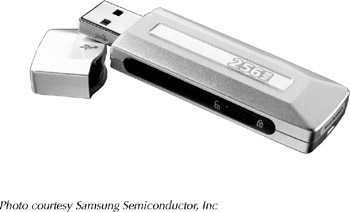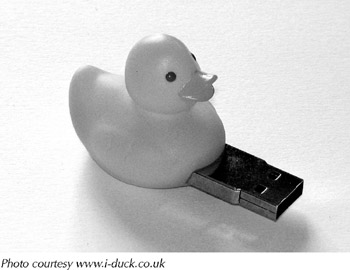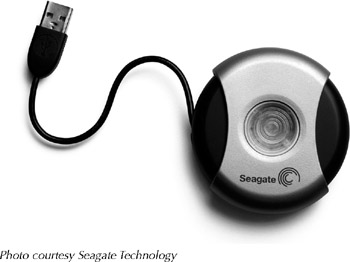USB Drives
The Universal Serial Bus (USB) standard is a specification for an I/O connection that can support many kinds of peripheral devices, ranging from simple things like mice and joysticks through keyboards and modems to complex devices like disk drives and other storage systems. Most personal computers and motherboards made since about 2000 include one or more USB ports.
USB was intended to overcome the proliferation of connectors that covered the back of most desktop computers and filled the edges of laptop machines. Before USB, most computers needed a serial port or two, a parallel port for the printer, PS/2 connectors for the keyboard and mouse, Ethernet ports for networking, and audio connectors for speakers, plus other, more specialized connectors for other input and output devices and services. USB replaced all of these with a standard connector that could support all of these services and more.
USB devices are supposed to be Plug and Play, meaning that the computer recognizes a USB device as soon as you plug it in (Plug and Play doesn't always work, but that's the goal). They're also hot swappable, so you can connect or disconnect a USB device without turning off the computer. To make connections even easier, the same cable that carries signal between USB devices and the computer can also supply power to those devices.
Some USB devices start working as soon as you connect them to the computer, but others don't work unless you have already installed the device driver or other software supplied with the device. Before you connect a USB device to your computer for the first time, read the installation instructions supplied with the device.
Most computers that have USB ports have at least two of them. Because each port can connect to a hub, it's possible to connect several separate devices to each port. The original designers wanted USB ports to support up to 127 devices, but the practical limit is closer to seven unless they're all relatively simple items like mice (not that you'd ever want 127 mice connected to the same computer).
Along with all those keyboards, mice, printers, sound controllers, and so on, USB can also connect one or more storage devices to a computer. These can be stand-alone disk drives, pocket-sized flash drives, or storage built into digital cameras and audio recorders.
Although every computer should have at least one internal disk drive to hold the operating system and other important software, separate USB drives can be a convenient way to increase the computer's total storage capacity. They make it simple to share data between computers at home and at school or between home and office, to back up your data, or to transfer data from one computer to another.
When a USB drive is connected to a computer, Windows detects the drive automatically (although it might take a minute or two), and treats it just like any other drive. It appears in the My Computer window and other drive directories with a temporary drive letter, with all the same features and functions as an internal disk drive.
Connecting a USB flash drive
USB flash drives are small storage devices that use electronic memory blocks (in integrated circuits) to hold up to several megabytes of data. Because they have no moving parts, flash drives can read and write data much more quickly than a mechanical disk drive.
Flash drives can be handy for carrying copies of important documents and other files wherever you go-your resume, family photos, even the manuscript of your novel-in-progress. The actual storage media are thumbnail-sized integrated circuits, which come inside a huge variety of packages, including pens, pocket-sized cases like the one in Figure 9.10, and thousands of novelty shapes, including small, plastic, glow-in-the-dark ducks (see Figure 9.11). Other USB flash drives double as tags for key chains or charms for necklaces.

Figure 9.10: Portable USB flash drives come in many forms, from simple and functional …
Photo courtesy http://www.i-duck.co.uk 
Figure 9.11: … to completely silly.
To connect a USB flash drive to your computer, simply plug the USB connector on the drive into a USB port, or use a USB cable to connect the drive to the computer.
External USB disk drives
External USB disk drives are standard IDE or SATA drives mounted inside separate cases that can connect to your computer through a USB port (some drives can also use FireWire/IEEE 1394 connections in addition to USB). They are sold both as self-contained packages that include the drive and the case, and separate USB enclosures with mounting hardware and cable connections for loose drives. Unlike the smaller USB flash drives, these full-sized disk drives require a separate power connection.
| CROSS-REF | Chapter 14 covers more details about using FireWire and USB interfaces. |
Halfway between full-sized disk drives and tiny flash drives, pocket-sized hard drives like the one shown in Figure 9.12 use 1-inch disk drives and retractable cables. They're slower than flash drives, but they often have space for more data.

Figure 9.12: Pocket-sized USB hard drives can hold a substantial amount of data in a small package.
EAN: 2147483647
Pages: 372